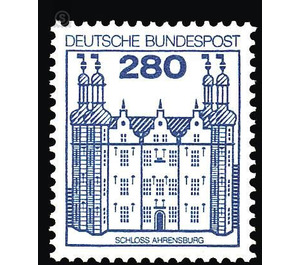Permanent series: castles and palaces - Germany / Federal Republic of Germany 1982 - 280 Pfennig
Theme: Architecture
| Country | Germany / Federal Republic of Germany |
| Issue Date | 1982 |
| Face Value | 280.00 |
| Color | brown |
| Perforation | K 14 |
| Printing Type | Lithography |
| Stamp Type | Postage stamp |
| Item Type | Stamp |
| Chronological Issue Number | 1015 |
| Chronological Chapter | GER-BRD |
| SID | 297258 |
| In 44 Wishlists | |
Supplementary values to the 1976/77 introduced roller-brand continuous series »castles and palaces«. The reel stamps appear simultaneously and identically with the inscription "Deutsche Bundespost Berlin". Castle Ahrensburg near Hamburg, an outstanding work of the late Renaissance, contains a precious equipment. Castle Arnesfeldes was probably in the 13th century Vogteisitz the Counts of Schauenburg. 1567 she acquired the Danish general Daniel Rantzau. 1569 his brother Peter inherited the lands and put in 1595 a new court with castle Ahrensburg at the village Woldenhorn. The property came in 1759 to Heinrich Carl Schimmelmann, from 1768 treasurer of the Danish king, from 1779 Lehnsgraf, in whose family he remained until 1932. The castle on an island in a meadow valley, designed in the middle of the 19th century to a landscaped park, was based on the model of Glücksburg: 3 longitudinally joined gabled houses with 4 octagonal corner towers, but in Ahrensburg are slimmer and wearing hoods. Delicate tail gables decorate the building. The interior, remodeled after 1759 by Carl Gottlob Horn and also 1855/56, shows on the ground floor the rooms from the time of Heinrich Carl Schimmelmann. The dining room features Louis XVI-style wood paneling, made in 1766 in Paris. In the porcelain room we find a Rococo stucco ceiling around 1760; in the staircase, built in 1760, a Rokokogeländer and stucco work. The late-Classicist ballroom on the upper floor was designed by M. Scherer in 1855; the parquet is outstanding. Valuable are the furniture, especially from the second half of the 18th century, such as Chippendale, Hepplewhite and Sheraton. Rich is the equipment with works of art: paintings by Philipp Hackert, portraits of Anton Graff and Johann Heinrich Tischbein d. Ä. (Extract from texts by the German Castle Association eV Braubach, Dr. W. Avenarius)


